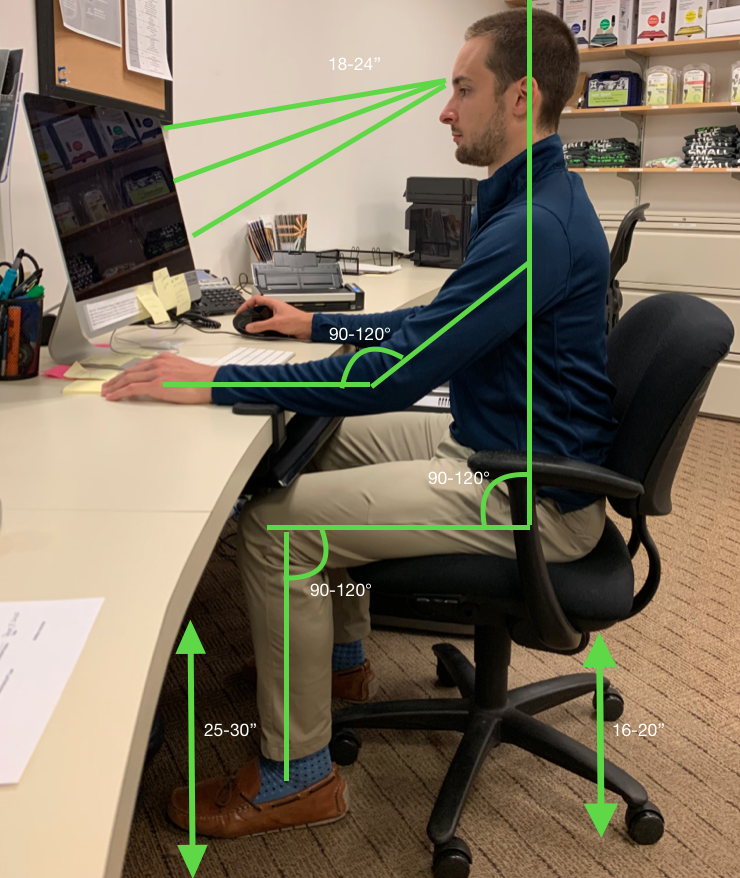Achieving proper workspace ergonomics
Whether you are working from home since the coronavirus outbreak or are now getting back into the office, workspace ergonomics is very important to your overall health and wellness. Your ergonomics play into your overall ability to perform in the workplace.

Workspace Tips and Tricks
Whether you are working from home since the coronavirus outbreak or are now getting back into the office, workspace ergonomics is very important to your overall health and wellness. Not only do your ergonomics play into your overall ability to perform in the workplace but have an impact on your health. Sitting and standing posture both at work and at home is highly important is key to preventing repetitive microtrauma to your muscle.
The average American over 18 spends six and half hours a day sitting, while teenagers spend nearly eight hours a day sitting, according to a 2019 survey of 50,000 Americans, and we can only imagine how high that number must be since the pandemic.
Now, more than ever, is it important to have good posture. We buy expensive mattresses because we realize how important having a supportive sleep position is, so we should be doing the same for our work positions. That does not mean you have to spend thousands of dollars on a fancy chair as long as you are mindful of what you sit on and find a chair that works for you. However, if you are looking for a custom chair, you can design the perfect chair for you at places such as Steelcase.
Once you are comfortable sitting, it will be easier for you to focus on your work, and not on the pain in your back.
Benefits:
- Decreased number of employees experiencing pain
- Increased productivity
- Increased morale
- Decreased absenteeism
- Increased company savings
Example of an Ergonomically Correct Workspace

Keys to Workspace Ergonomics
Follow these directions to find right position for you. For more information, you can check out the National Institute of Health and the Occupational Safety and Health Administration’s guidelines.
The Chair
- Height – Sit with feet flat on the floor and thighs parallel to the floor.
- Footrest can be added for appropriate angle.
- Backrest recline and tilt – Choose an office chair that reclines and tilts with tension control help alleviate stress on the spine (should tilt at least 135 degrees).
- Lumbar support – Natural curve to support your lower back (like a shoe insole for your back).
- Seat depth – Ideal depth is 16.5″ and 14-18.5″ for adjustable seats.
- Arm rests – Armrests that have various settings
- Material – Mesh fabric that is comfortable and supportive
The Desk
- Desk should be 25-30" high and allow for feet to be flat, thighs parallel to floor and knees at 90 degrees.
Monitor Position
- About one arm's length or 20” away from your screen
- Screen should be angled 10–20 degrees upward
- Top of the screen should be at your eyebrow level
Tips and Tricks from Performance Staff
“Pretend there is a string from the top of your head to the ceiling and someone is gently pulling you up from it.” - Jon Mendola, DPT, CSCS, FDN
“For driving: Take a look once you get in the car and in good posture and take a mental image of what is in your mirror. Every few minutes look again and take notice if the image is a different angle. If it is, you need to reset.” - Jon Mendola, DPT, CSCS, FDN
“Get up every 10 minutes to walk around and stretch.” - Benny Salanitro DPT
“Roll up a towel underneath your forearms to keep your wrist in a good position for typing.” - Benny Salanitro, DPT
“Put a sticky note on your computer screen that says, “sit up” to remind you every time you notice it.” - Rob Mahlman, DPT, OCS
“Every 20 minutes, look 20 feet away for at least 20 seconds, then get back to work.” - Ashley Moriarty, DPT
RECENT POSTS
CATEGORIES

> Privacy Practices
> Terms and Conditions
Copyright © Performance 2022.
All rights reserved.
JOIN OUR COMMUNITY
Sign up for our mailing list to learn more about Performance, stay up-to-date on our offerings, and receive our newsletter.
Digital Marketing by Rebel Interactive Group
